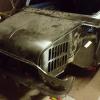Posted 28 November 2016 - 01:19 PM
It is not like a spring washer in some cases, but it is in many others, maybe most!
Those where the locking function is provided have radial "teeth" under the head which have a vertical (almost) edge and a sloping edge, so they can be done up easily but are difficult to remove, but only on relatively soft surfaces. A hardened washer would defeat the locking action as the teeth would not dig in. It is easy to tell by simple inspection whether you have this kind of bolt.
The other reason, which is possibly true in the vast majority of cases (in many instances, both reasons apply), is that the bolt is intended for robotic insertion, in which case the hexagon is commonly smaller than normal too. To determine if that is the case, see which socket fits. The older bolts were 5/16" and the head was 1/2" AF. Robotic insertion uses a hex at least one size smaller and maybe even metric.
If in doubt you can always replace by standard bolts (check whether thread is UNF or UNC) with ordinary split lockwashers, which worked perfectly well for many years, and avoid potential problems with tiny hexagons stripping.

















